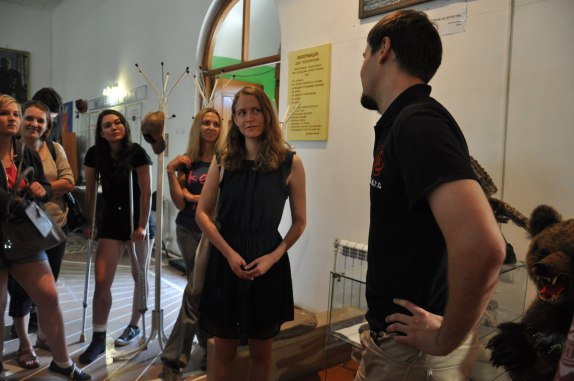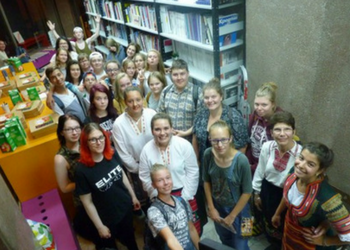IVS volunteer Emily has just finished her EVS placement with Interra for six months in Russia. This is her last blog post.
One Week, Two International Projects
For a week at the beginning of August, Krasnoyarsk was filled with new faces, new ideas and different languages, as Interra hosted two groups of young people from Germany, Bulgaria and Finland. We organised two different projects – PhotoСинтез, a project for school students about photography, art, history and culture, and an International Summer School for German and Russian students, focused on business, social enterprise and the work of NGOs.
A few months ago, Lena, one of the organisers of the Summer School, asked me to translate the project programme into German and English, and with the words “business trends in the 21st century”, “social enterprise” and “intercultural competencies” floating around in my head, I wasn’t really sure what to expect from the project and its participants. I didn’t think I would have much to do with the actual project apart from translating the programme. I definitely didn’t expect that I would be invited to participate in so many parts of the Summer School and that I would be able to meet and befriend the other participants from different parts of Russia, Germany and Italy.

Even though I don’t know a lot about business or enterprise, the summer school turned out to be a hugely interesting and useful experience, made up of five days of training and a few excursions to different parts of the city and Krasnoyarsk Krai. The early-morning training workshops were always attended by tired faces which eventually broke into laughter and interesting discussions as we approached controversial topics, watched videos, listened to lectures from experts and developed our own projects and ideas in groups. The workshops were led by trainers and experts from Germany and Russia, and at the end of the training, the participants also had the chance to lead workshops on topics that interest us (I led a discussion group about food consumption!). On one evening, we also watched a documentary film about modern-day consumption and the clothing industry outside our office OKNA, huddled under blankets, with a view of the Yenisei river under a grey sky and yellowing trees which hinted at the beginnings of autumn.
On Saturday, we visited three different villages located near Krasnoyarsk. Travelling along endless dusty roads through hot, dense air, we took the chance to enjoy the vast Siberian landscapes and catch up on some missed hours of sleep. After miles of gravel, cows wandering by the roadside and tomatoes just beginning to ripen in greenhouses, we visited three villages, two churches, two museums and a kindergarten. A local family treated us to a huge traditional Russian lunch and home-made tea, as well as letting us relax in their shady colourful garden; we glimpsed inside one of the oldest churches in Krasnoyarsk Krai, whose wooden walls were still adorned with century-old painted icons; and I even had the opportunity to translate a museum excursion from Russian into English, so that the participants from other countries could understand the exhibitions and communicate with our guide.
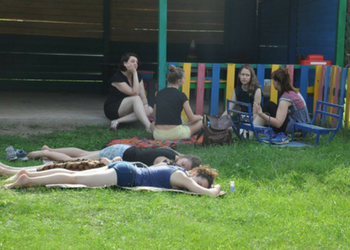
I joined the participants of our second project, PhotoСинтез, for their hike in Stolby national park on Thursday, and went to the Bulgarian Evening in OKNA on Friday evening. The participants of the project were so open and positive, and it was really interesting to talk to young people of different nationalities and backgrounds about their impressions of Krasnoyarsk and of the project, as well as seeing the friendships that had been formed despite language barriers and cultural differences. While we walked through the mountains feeling the early traces of autumn and the constant threat of rain in the air, the Russian participants felt cold, the Finnish participants felt warm, and I felt at home under the Scottish grey sky and gusts of wind in the trees. On Friday at the Bulgarian evening, we were treated to some traditional Bulgarian food, found out more about the country and watched some traditional songs and dances.
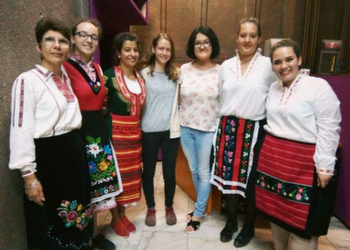
One of the nicest things about participating in these projects was the fact that I really felt like a local in a city which was once so foreign to me. I spent the week explaining bus routes, recommending cafes, translating menus and interpreting conversations, in a city which, 4 months ago, was completely unfamiliar, new, large. Living abroad is always an opportunity to feel “at home” in a new place, build a whole new life, and to observe how overwhelmingly foreign streets, buildings, islands and bridges become aspects of everyday life. They become landmarks seen from the bus window on my daily commute, places where I have walked with friends, had lunch, organised events, met new people, stepped in puddles and ruined my shoes on rainy days.
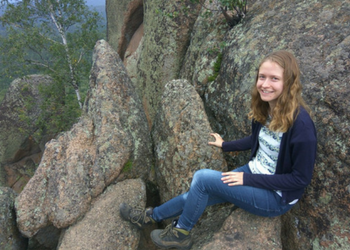
As an honorary local, I felt irrationally proud to see the participants from different countries learning to understand and love Krasnoyarsk. They became good friends with the Russian project participants, communicated with the locals and found, among dusty streets and harsh grey tower blocks, beautiful places and kind people. At the beginning of the week, one of the German students told me “It’s nice, but I could never live here.” At the end of the week, she said “You know… maybe I could stay a bit longer after all.”
P.S. Thank you Interra and IVS for giving me the opportunity to participate in projects like these as part of my job! This was one of the most interesting weeks so far of my EVS placement, but every week is filled with interesting events, conversations, and meetings with new people 🙂
You can read all of Emily’s blog posts from Russia here.

